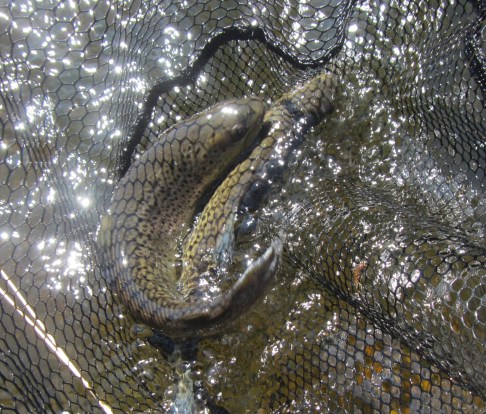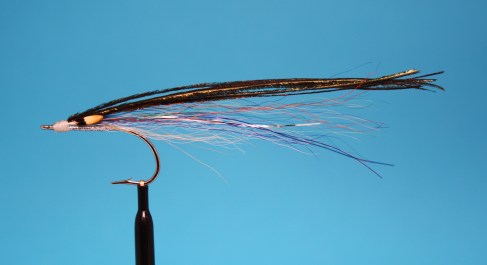“People tell me I’m the world’s greatest comedian. Ask me why people tell me I’m the world’s greatest comedian.”
“Why do people tell you –“
“Timing!”
Sometimes it’s like that with wet flies. Time the hatch just right, and you can look like the second coming of Joe Brooks. Legions of obliging trout and the right fly don’t hurt, either.
Such was my good fortune on Wednesday. The DEEP had recently stocked the upper TMA with several thousand trout. Armed with this intelligence, I met Todd Kuhrt and his brother in New Hartford, and we were on the water by 10:30am. We had won the April weather lottery, with blazing, brilliant sunshine and temperatures that were supposed to climb into the low 60s. I was rigged up for nymphing, so I wandered off to the head of a deep run while Todd and his brother set up shop a hundred yards downstream.
A nice holdover brown taken on a Dark Hendrickson winged wet.

Catching nothing when you’re expecting to bail fish is lesson in humility, and I took my licks for an hour. By the time had I worked my way down to Todd and Scott, I still hadn’t had a touch. They had each taken three on nymphs. The ignominy.
But, sometimes you must endure such hardships to reach Nirvana. I realized that what I really wanted to do on this glorious spring day was swing wet flies, smoke cigars, and relish the fact that I was blowing off all the work to do. So I swapped out my nymph rig for a team of three wets I had tied up the night before: a size 14 Partridge and Green dropper, a size 12 Squirrel and Ginger caddis in the middle, and a classic Hendrickson Dark on point. I had just finished nymphing a run, and now I made a quartering cast downstream. The trout hit just after the third mend. First cast. Wet fly. Squirrel and Ginger.
Life was good again.
It was about to get great.
For the previous fifteen minutes, I had been eyeballing some splashy rises about 50 yards downstream from me. Unfortunately, a spin angler had the area on lockdown. But now he was packing up his gear. I coiled my line in my hand and made a beeline for the trail along the river’s edge. This being a gentleman’s sport, it’s probably uncouth for a middle-aged man to race through the woods with his fly rod just to secure a fishing spot. But sometime we must toss propriety to the wind and indulge our inner barbarian.
The fly of the morning, my Squirrel and Ginger caddis wet.

The air was teeming was caddis, and the surface film was being punctured by the slashes of feeding trout. I couldn’t see any bugs on the water, so I figured the trout were taking emergers just below the surface. That’s the cool thing about newly stocked fish on the Farmington. They discover pretty quickly that those food pellets aren’t on the menu anymore. I picked out a rise, and made a cast. Bap! On the caddis emerger. In fact, the first eight trout I caught all picked that Squirrel and Ginger out of my lineup of three. I clipped off the Hendrickson and tied another caddis on. I soon had my first double.
Crazy kids. My first double of 2013.

OK, so they were just dumb stockers. But, it’s hard to embrace self-loathing when you’re having so much fun. I waved Todd and his brother down so they could get in on the caddis orgy that was – hard to believe – building in intensity. I can’t say it was a fish on every cast. But I also can’t remember too many drifts that didn’t draw a strike. All you had to do was look for a rise, then swing your fly over it.
It would have been unfair to expect a repeat on the lower TMA. I really just wanted to see if the Hendrickson hatch was in full swing. Turns out that it was. We got to our target pool around 2:00pm. Same intense, splashy rises, and the air thick with windblown Hendrickson duns. Same drill, too: find a rise. Swing your fly over it. Come tight to the take that was sure to follow. Unfortunately, Todd and his brother had to leave at the height of the action, but I stuck it out for another 45 minutes until the hatch wound down. Upstream, it had been all stocked browns; here, the fish were bigger, with a substantial number of fat rainbows and a few big holdover browns in the bargain.
Ending on a high note: the best fish of the day was my last, this chubby holdover brown hen.

That night, I noticed a little sunburn on my hands. My arm was pretty sore, too. Life’s tough, you know?























